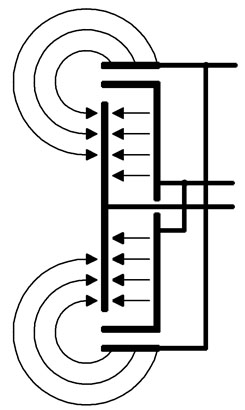Similar to inductive sensors, capacitive sensors are available in two basic versions. The first type is the flush or shielded or embeddable version however with capacitive sensors they are sometimes referred to as object detection sensors. The second type is the non-flush or non-shielded or non-embeddable version however again with capacitive sensors they are sometimes referred to as level detection sensors.

The flush or object detection capacitive sensors are shielded and employ a straight line electrostatic field. This focused field is emitted only from the front face of the sensor allowing the sensor to be mounted in material so that only the face of the sensor is visible.
The highly focused electrostatic field is perfect for detecting small amounts of material or material with low dielectric constant. The typical range of a flush 18mm capacitive sensor is approximately 2 to 8mm depending on the objects dielectric constant. As with any capacitive sensor the sensor should be adjusted after installation.

If the sensors are mounted adjacent to each other the minimum gap should be equal to the diameter or the adjusted sensing distance whichever is less. These sensors can also be mounted opposing each other however the distance should four times the diameter of the adjusted sensing distance whichever is less.
 Shielded or flush capacitive sensors are perfect for detecting solids or liquids through non-metallic container walls up to 4mm thick. If you are detecting liquid levels through a sight glass with the sight glass mounting bracket then the flush mounted sensor is the preferred choice.
Shielded or flush capacitive sensors are perfect for detecting solids or liquids through non-metallic container walls up to 4mm thick. If you are detecting liquid levels through a sight glass with the sight glass mounting bracket then the flush mounted sensor is the preferred choice.
 The non-flush or level detection capacitive sensors are not shielded and employ a spherical electrostatic field. This field is emitted from the front face of the sensor and wraps around to the sides of the sensor head. Unlike the flush sensor this version cannot be mounted in material where only the face of the sensor is visible. Non-flush sensors have better characteristics and better performance in applications with adhering media.
The non-flush or level detection capacitive sensors are not shielded and employ a spherical electrostatic field. This field is emitted from the front face of the sensor and wraps around to the sides of the sensor head. Unlike the flush sensor this version cannot be mounted in material where only the face of the sensor is visible. Non-flush sensors have better characteristics and better performance in applications with adhering media.
 The spherical electrostatic field provides a larger active surface and is perfect for detecting bulk material and liquid either directly or indirectly. The typical range of a flush 18mm capacitive sensor is approximately 2 to 15mm depending on the objects dielectric constant. As with any capacitive sensor the sensor should be adjusted after installation.
The spherical electrostatic field provides a larger active surface and is perfect for detecting bulk material and liquid either directly or indirectly. The typical range of a flush 18mm capacitive sensor is approximately 2 to 15mm depending on the objects dielectric constant. As with any capacitive sensor the sensor should be adjusted after installation.
 If the sensors are mounted adjacent to each other the minimum gap should be equal to three times the diameter or the adjusted sensing distance whichever is less. These sensors can also be mounted opposing each other however the distance should four times the diameter of the adjusted sensing distance whichever is less.
If the sensors are mounted adjacent to each other the minimum gap should be equal to three times the diameter or the adjusted sensing distance whichever is less. These sensors can also be mounted opposing each other however the distance should four times the diameter of the adjusted sensing distance whichever is less.
Shielded or flush capacitive sensors are perfect for detecting solids or liquids through non-metallic container walls up to 4mm thick. If you are detecting liquid levels through a sight glass with the sight glass mounting bracket then the flush mounted sensor is the preferred choice.
Capacitive sensors are perfect for short range detection of virtually any object regardless of color, texture, and material.
To learn more about capacitive sensors visit www.balluff.com.

